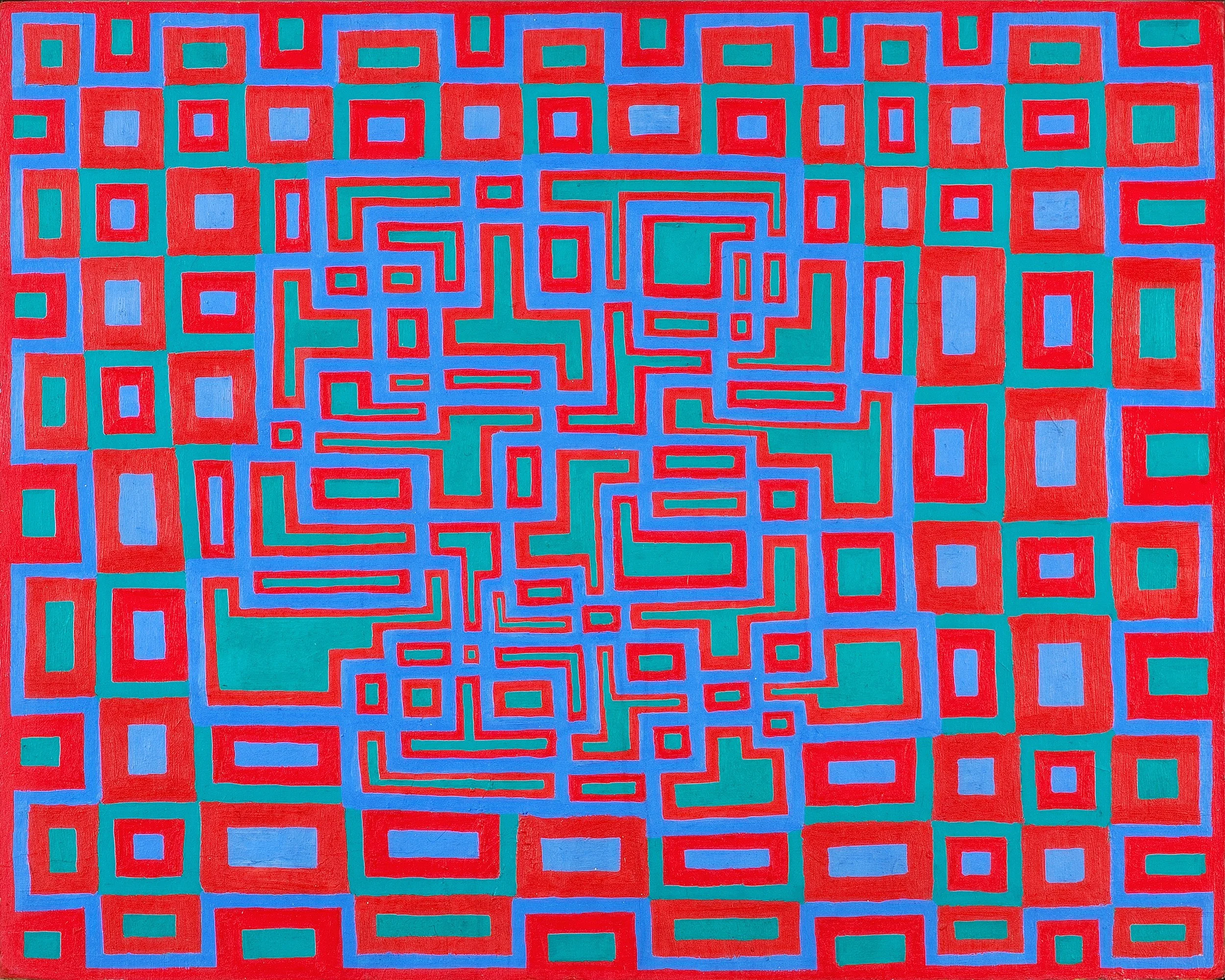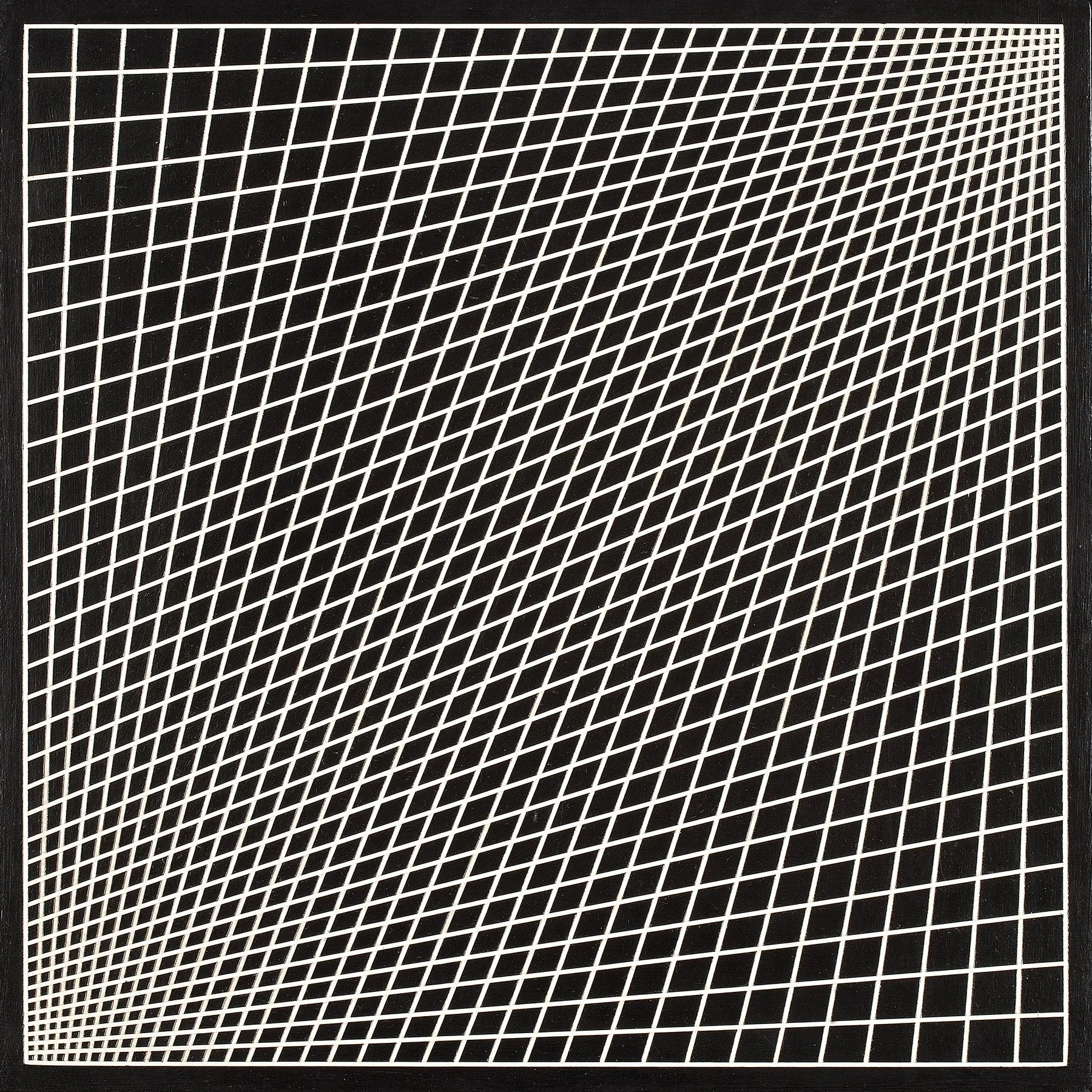RICHARD ANUSZKIEWICZ (1930-2020)
Available Work | Biography | New York Times Review
Biography • Richard Anuszkiewicz (1930-2020)
Richard Anuszkiewicz in his studio, 1965.
Richard Anuszkiewicz was born into a Polish-immigrant family in Erie, Pennsylvania. Through a high school art teacher, Anuszkiewicz learned of Impressionist color theory, the Ostwald system of complementary colors, and the spectrum prism. Anuszkiewicz went on to study at the Cleveland Institute of Art (1948-1953), where he began to simplify landscapes and still lifes into studies of design and abstraction. Upon graduating from the Cleveland Institute of Art in 1953, Anuszkiewicz was awarded a Pulitzer Traveling Scholarship by the National Academy. In 1954 Anuszkiewicz went to Yale University where he and his roommate, artist Julian Stanczak, studied with Josef Albers. Anuszkiewicz received a Masters of Fine Art from Yale in 1955.
Through Albers, Anuszkiewicz learned of the Bauhaus and Paul Klee’s principles of color, which had an immediate effect on his work. In Albers’s course at Yale, the relativity of color was taught through color problems assigned to the students after each class. Albers did not teach a color theory with set rules, but rather taught a disciplined method of examination that encouraged students to look objectively at their paintings. While at Yale, Anuszkiewicz began to read the latest findings by psychologists on perception, which led to his master’s thesis, A Study in the Creation of Space with Line Drawing. Focusing on perception, the thesis discussed five ways to create space: variety of line, overlapping, reduction of detail, perspective, and size.
In 1956 Richard Anuszkiewicz attended Kent State University in Ohio where he received a Bachelors of Science in Education, as he planned to teach as a supplement to his painting. Anuszkiewicz later held visiting artist positions in 1967 at Dartmouth College and in 1968 at University of Wisconsin-Madison, Cornell University, and Kent State University.
While teaching at Kent State in 1956, Anuszkiewicz had a solo exhibition at the Butler Institute of American Art in Youngstown, Ohio. In 1960 Anuszkiewicz had his first New York solo exhibition at The Contemporaries gallery. The exhibited paintings showed sharply contrasted colors in calculated geometric compositions, which provoked the viewer to see colors shifting and shimmering, forms reversing, and spatial depths adjusting. The compositions were self-contained and centralized and the colors shifted from figure to ground and vice versa. The Museum of Modern Art purchased one of Anuszkiewicz’s paintings from the exhibition.
Museum interest in Anuszkiewicz continued to grow in the early 1960s. The Whitney Museum of American Art included Anuszkiewicz in its 1962 exhibition Geometric Abstraction in America, its 1963 annual, and the 1967 exhibition Art of the United States, 1670-1966. In 1963 the Museum of Modern Art featured Anuszkiewicz in its Americans 1963 exhibition and Time magazine published a story on him. In MoMA’s 1965 exhibition The Responsive Eye curated by William Seitz, Anuszkiewicz was featured as one of the preeminent American Op artists. Also in 1965 Anuszkiewicz had his first solo exhibition with the Sidney Janis Gallery in New York, where he had further solo exhibitions in 1967, 1969, and 1973. Anuszkiewicz exhibited three works at the 1965 Corcoran Biennial in Washington, DC, in addition to making the Biennial’s exhibition poster. Anuszkiewicz was included in American Art Today at the 1964 New York World’s Fair and American Painting Now at the United States Pavilion at Expo ‘67 in Montreal, Canada.
Anuszkiewicz exhibited in The Structure of Color at the Whitney Museum in 1971 and the Corcoran Biennial in 1975. The Brooklyn Museum held a solo exhibition of Anuszkiewicz’s work in 1980, which traveled to the Carnegie Museum of Art, Pittsburgh, Pennsylvania. In 1986 Anuszkiewicz exhibited at the Venice Biennale and in 1988 he was included in the Metropolitan Museum of Art’s exhibition It All Begins with a Dot: Exploring Lines in 20th Century Art. More recently, Anuszkiewicz received the Lorenzo the Magnificent Award for career achievement at the Florence International Biennale of Contemporary Art in 2005.
In 2007 Anuszkiewicz was featured in Optic Nerve: Perceptual Art of the 1960s at the Columbus Museum of Art, Ohio and in Op Art at the Schirn Kunsthalle in Frankfurt, Germany. His painting Celestial, 1966 was includedin the 2010 traveling exhibition Psychedelic: Optical and Visionary Art Since the 1960s organized by David Rubin at the San Antonio Museum of Art. The Cleveland Museum of Art’s exhibition CLE OP: Cleveland Op Art Pioneers in 2012 celebrated Anuszkiewicz, Julian Stanczak, and the Anonima Group as founders of Op art connected to the Cleveland Institute of Art. The monograph Richard Anuszkiewicz: Paintings and Sculptures 1945-2001 was published in 2011.
Works by Richard Anuszkiewicz can be found in the following New York museums: the Metropolitan Museum of Art, the Museum of Modern Art, the Solomon R. Guggenheim Museum, the Whitney Museum of American Art, and the Brooklyn Museum. His work is also included in the permanent collections of the Art Institute of Chicago, IL; the Museum of Contemporary Art, Chicago, IL; the Cleveland Museum of Art; Ohio; the Hirshhorn Museum and Sculpture Garden, Washington, DC; and the Philadelphia Museum of Art, Pennsylvania.



